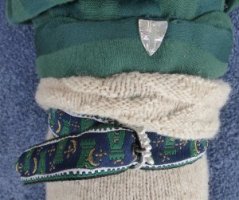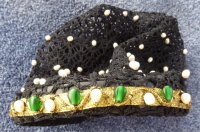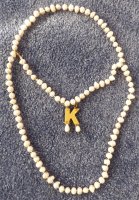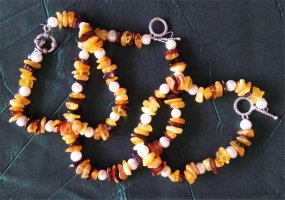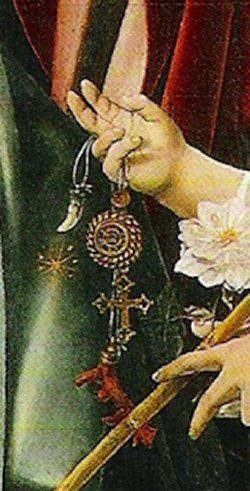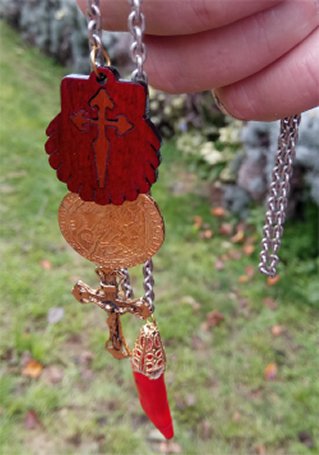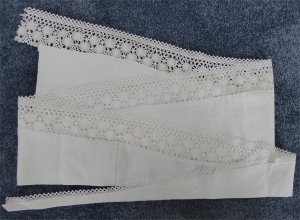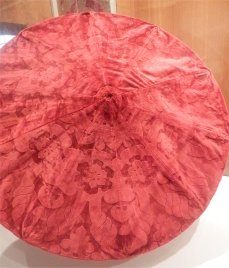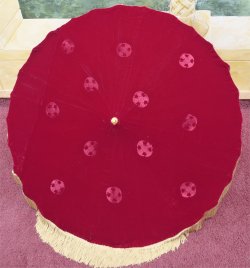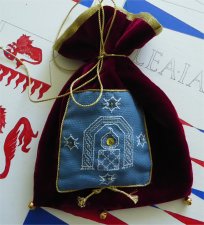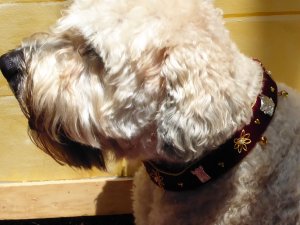 |
|
A&S Challenges: Garb and AccessoriesGarters, Baronial Travel Coronet, Coif Bling, Peerage Chapeau Other A&S Challenge Topics VPC3: Hitting Below The Knee : Show us your garters!
I saw an appealing trim at Pennsic and loved it as it has my tower, even if I had to settle for green, rather than white. But I knew the pattern was far too mundane for me to be comfortable using it visibly. So, having already repurposed the lovely garters Catherine d'Arc made me into a travel coronet (VPC 24), I thought a pair of garters would let me use the trim in a hidden but useful fashion, and answer another Variety Pentathalon challenge. I sewed petersham ribbon on the back for sturdiness and grip, added pewter buckles cast by Sir Sebastian, and whacked a grommet in for a hole. They keep the new hose -- Mistress Ginevra's creation from Shetland wool with laurel leaves around the top! -- up nicely. VPC24 : Remake, Reuse, Refashion, Reconsider : Travel CoronetThis tablet-woven mini coronet was inspired by Viscountess Mountjoye's spiffy example at Canterbury Faire. While we have stunningly beautiful coronets made by Master Edward Braythwayte, a fabric option means I don't have to worry about security getting snippy about the pins that hold the latter together. This travel coronet uses one of the lovely tablet-woven garters Mistress Catherine d'Arc gave me, which displays the curs' heads and tower from my arms, my motto, as well as my livery colours. I had felt guilty at not having occasion to wear them as I did not typically wear hose at the time. So it seemed kismet that the garters were just long enough to wrap around my head and suitaby pretty to base a travel coronet on.
The garter has been embellished with the six pearls of a Court Baroness. The copper and brass vertical mounts are actually letterpress printers' thins used to make type tight, a subtle reference to my Laurel speciality of reproduction period printing. I later bought some lovely trim in Oman in red and white to make a travel baronial coronet for my lord-husband. VPC19: Embellish It : More Coif Bling!
Being exhorted to embellish or decorate an existing item proved to be one of the easier challenges. Adding pearls, beads and some couched gold thread and trim has blinged up a plain commercially made hairnet (found hanging off a parking meter in Monaco!). It is loosely based on Tudor/Italian style headwear. Finally my hair has grown long enough to plait it with ribbons and loop the braids across my head. This rather tightly fitting coif makes an excellent cover for the back of the head to hide all the messy bits. Peerage Chapeau V1.2When I was Laurelled, I made a peerage chapeau, a version of a cap of maintenance, in blue for a Scottish landless baron, with rabbit tails taking the place of ermine, and a bejewelled laurel headband to hold it on my head. It worked well right up to the point where my dog was feeling peckish....turns out the rabbit tails (supplied as cat toys by the local pet shop) were not fully cured, eeuuwww. So I have revamped the chapeau, this time with an actual ermine, paws, tail and all, taken off a shoulder stole of ermines. Their tiny lttle skeletons are a bit fragile -- two of them had lost their distinctive brown tail tips. Most depictions of ermine used in clothing have them sewn together flat with just the tips showing, so I was pleased to come across a massive painting in the UK's National Portrait Gallery of Veronese's Family of Darius before Alexander, which showed a shoulder cape with bumpy bits of paws and dangly tails, very similar to my stole. Turns out I now have a silly peer trick -- I can flick the fur forward from its usual vertical hanging position to horizontal across the top of my head. Well, it amused me. VPC4: The Neck Best Thing : K is for Katherine Kerr
This challenge was for an item intended for use on, around, or above the neck. This necklace is based on the well-known portrait of Anne Boleyn from the UK's National Portrait Gallery, in which Anne has a capital B suspended from a pearl choker around her neck. I've had a craftwood initial K for a number of years, but delayed making this, hoping to be able to find a metal K rather than use a wooden one. Some slathering of gold paint has produced something that may pass in low light and I finally found a use for the large string of freshwater pearls I've had for a while. Amber BraceletsGubbins 4: With scarfs, and fans, and double change of bravery, With amber bracelets, beads, and all this knavery, ie an accessory your persona may have owned, made, used, or gifted.
My father spent much of his life in Europe, in France as a member of the Scots Guard for Francois I, then as a hired soldier with Giovanni Della Bande Nera's Black Company, and ended up as an engineer-trader in Venice after he was lamed at Pavia. I found this string of Baltic amber chips in one of his coffers after he died and had them made into bracelets. I had a very long string of Baltic amber chips, purchased in Lithuania, just waiting for a suitable project. I don't play Viking – the culture I most associate with amber -- so didn't expect to use them, but this mention of amber bracelets in the Gubbins Challenge inspired me into action. So I have strung on silk groups of the chips interspersed with freshwater pearls; this is a common style for the 16th century in both Venice and Scotland. Bracelets were generally worn in matching sets, so I made two for me; the additional one was a tad long so it was donated to Baronial largesse. VPC1 Child's Play: a charmIn Bernardino di Antonio Detti's painting Madonna della Pergola (1523), a child holds a short chain from which dangle a number of charms: a dog's tooth (for teething); a small coin or medallion (possibly bearing a saint's image); a cross; and a short branch of red coral (also for teething as well as good health). My charm bears a pilgrim's scallop token from Santiago de Compostela; a coin (a Richard III gold angel, showing the Archangel Michael slaying a dragon on one site and a galley ship on the other); a cross; and a piece of red coral. I have since added a tooth which looks like a dog’s tooth (our dog was not willing to supply one); it is, in fact, a seal tooth, recovered years ago from a mouldering skeleton on a beach near Takaka.
VPC25: Containment System : Swaddling Clothes, containment for a baby, not their by-products!This is part of the Venetian swaddling band my mother wrapped me and my short-lived brothers in.
Swaddling bands appear in a number of Renaissance paintings , such as Laviania Fontana's Newborn Baby in a Crib (1583). Extant Italian examples from the 1570-90s can be seen in the V&A and Met. Typically they are made of white linen doubled up and edged with a lace or embroidered band (including whitework, reticella, stem sttich, interlacing); rectangular at the wider end (12-24cm) and tapering to a point along a 2-3-metre length. The shape is to allow a spiral band of the fancy work to show as the final layer of swaddling cloth is wrapped around the child. My one is made of a linen-like cotton from my scrap pile; with lace purchased on Burano, the lace-making island in the Venetian lagoon; and Spotlight trim whip-stitched on as an edge. VPC10: Cover Me : Canterbury Faire ParasolAlso many of them doe carry other fine things of a far greater price, that will cost at the least a duckat, which they commonly call in the Italian tongue umbrellaes, that is, things that minister shadow unto them for shelter against the scorching heate of the Sunne. These are made of leather something answerable to the forme of a little cannopy, & hooped in the inside with divers little wooden hoopes that extend the umbrella in a pretty large compasse. They are used especially by horsemen, who carry them in their hands when they ride, fastening the end of the handle upon one of their thighes, and they impart so long a shadow unto them, that it keepeth the heate of the sunne from the upper parts of their bodies. When I saw a 15th-century Venetian cut velvet parasol in the Museu Calouste Gulbenkian in Lisbon (pictured below), I knew I was going to have to make one for our sun-shy Baroness. Canopies, ombrellas or para-sols date in Europe to at least the 13th century but really became popular as a personal item in the 15-16th centuries. Initially employed as large square canopies with multiple poles, they were designed to emphasis the status of the pope, doge or temporal authority beneath. Velvet, satin and silk were common high-status fabrics of choice, with gold fringing, tassels and fancy buttons and lace adding to the item – Mary Queen of Scots is said to have had something along these lines. In 1530, Girolamo dai Libri painted the Madonna dell Ombrella, in which a cherub shelters the Holy Mother with a large red affair. Parasols tended to have long poles so they could be carried by an attendant. The Canterbury Faire parasol is of embossed red velvet with gold fringing. The embossing is surprisingly easy to do – place a lightly dampened area of silk velvet face down on a stamp and hold an iron, set to dry cotton/wool, hold it without moving for 10-20 seconds. If your iron has lots of steam holes, you can tape kitchen foil across the plate so you don’t end up with dots. The parasol itself is a bamboo-framed one from a local emporium, supplying the essential structure.
VPC16: Give What You Get : Kingdom A&S PouchThis was to be a project to be given to the Barony or Kingdom, whether gifted or as largesse, and it breathed life into a long-held intention.
When you become Kingdom A&S Champion you are awarded a pouch with the symbol of the Champion on it, though this is more often honoured in the breach than the observance (I had two pouches for four championships). It is generally assumed that a Champion will make a pouch for a future awardee, though I suspect this is not often mentioned to the recipient (bad luck if you got it in categories like armour making or carpentry!). Years ago I started to put together a guide to making the pouch, based on Mistress Rowan’s very helpful guidelines for the Lochac Order of Grace pouch, covering a range of styles and stitches. But earthquakes and Life got in the way and it fell by the wayside until the Variety Pentathalon Challenge. I went back to the original guide material I put together and made a Bayeux stitch pattern and a counted stitch blackwork pattern, along with collating suitable pictures and stitches for other types of work. My intention was to make one and ask a number of people far more competent than me to participate to make a batch of Kingdom A&S pouches so that future recipients could choose one to match their own persona. I think three or four got passed on to the A&S Minister. VPC23: Togs, Togs, Undies : Woof! Nice Collar for a Good DogThis challenge included an item of clothing intended for a specific purpose: eg, swimming, cooking, hunting, hawking, sports. While horse barding was appealing, it was a tad too much specially for someone horseless; then my dog Mercalli caught my eye...
So here’s a dog collar, based on the comments and illustrations in Gaston Phoebus’ 15C Book of the Hunt, and from illuminated manuscripts. Common features of such collars: red velvet, white silk; embroidery with gold thread or wire; a leashing ring, single eyelet; rumbler bells (mostly with small dogs), studs of various kinds. I was particularly delighted to read that the Boke of St Albans describes the kind of dogs to be found in a medieval Scottish town including a "butcher's hound, midden dog, trundle-tail, prick-eared cur and "smale ladies popis that beere away the flees” (Smith, pg 869). Phoebus also describes a “good” alaunt as white with sharp [ie pointed] standing ears surrounded by black spots (Ch XVI). My version, modelled by Mercalli ("what a good dog!"), made from various random bits and pieces, including a Kerr cur (made by Sir Sebastian), my tower (belt mounts) and other bling. A lovely paen to the Corsini family's household dogs caught my eye at an art exhibition in Ildhafn City; it was in a cartouche on a rendition of the family tree: References
| ||||||||||||||||||||||||||||||||||||||||||||||||||||||||||||||
